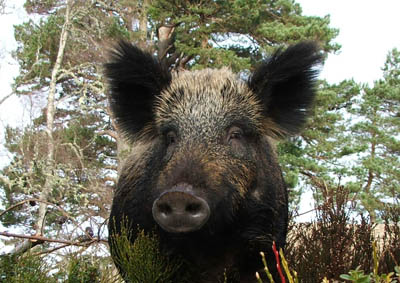How to control wild boar
Paula Lester takes a look at the growing problem of wild boar in the UK and how to deal with them


Wild boar have only recently re-established themselves in Britain, but the debate about how to manage these secretive animals and whether they should be here at all could run and run. Once a native species, wild boar became extinct more than 300 years ago through over-hunting and habitat loss, but have made a comeback following accidental and deliberate releases from farms, parks and abattoirs. They have established small breeding populations in Kent and East Sussex, the Forest of Dean, Herefordshire, Dorset and Devon.
Escapees from a Devon farm had to be rounded up by the Dulverton Farmers’ hunt some had roamed 40 miles. Last year, Defra estimated there were about 1,000 wild boar in England, although some believe the true figure is much higher. It’s a year since Defra launched its Wild Boar Action Plan, and, although groups such as the National Gamekeepers’ Organisation called for eradication, the policy of giving landowners and communities the power to cull animals that threaten the environment, farming or human safety was largely welcomed.
‘They’re a fascinating, highly charismatic and intelligent species that has reintroduced itself via the back door,’ says boar authority and former Defra scientist Dr Martin Goulding. Although some welcome boars’ return and the benefits they bring to ancient woodland, there are concerns over their impact on agriculture (boar like maize, potatoes and turnips) and gardens, as well as the risk of their transmitting diseases, causing road accidents and even attacking people. They reproduce rapidly, producing litters of eight to 10 each year, and have even been known to infiltrate pedigree pig farms with startling inter-breeding results.
Dr Goulding now has doubts about the effectiveness of the Government policy. ‘At the time, there were several indications that it had been hastily written, and, since then, there’s still been no action. It’s a fine idea to let landowners decide if they want wild boar, but the Government still hasn’t told them how to do it. There’s no close season for culling, which isn’t sensible management it’s barbaric. They’re still not telling people what calibre weapon to use, whether to shoot them in the day or at night, with a lamp, or from a high seat, and so on.’
However, a Defra spokesman is confident that its policy is the right one and will review it after three years, plus other options. ‘People are now able to decide how to manage feral wild boar according to the local situation,’ says the spokesman, adding that guidance on controlling wild boar responsibly is available. Peter Watson, executive director of the Deer Initiative (DI), confirms that best-practice guide-lines should be on the DI website by May. ‘I think wild boar are an asset rather than a problem, but we have to manage them.’
Most people agree that shooting boar with a high-powered rifle is the best way to control numbers. Charles Wilson, wildlife specialist at Natural England, believes established populations in Kent and Dorset have been kept under control by culling. ‘It’s too early to say how effective the overall strategy will be in the longer term, but we’ll see how things go.’
‘Whether we like it or not, shooting is the only way, but we must do it efficiently; an injured wild boar is horribly dangerous,’ warns Dr Goulding, who also dismisses Defra’s study into the use of immuno-contraceptives in feral females. ‘Contraceptives are something for the future, they’re not a magic bullet. We’ve never had an animal like wild boar in recent history. People are frightened of them, but we need to respect them and learn how to live with them.’
Exquisite houses, the beauty of Nature, and how to get the most from your life, straight to your inbox.
Boar and the law
There are no specific restrictions governing wild-boar control, although police firearms licensing branches require that wild boar are specifically listed on a firearms certificate (FAC).
The police don’t consider the term ‘other vermin’, which appears on FACs to permit the culling of species such as foxes, to include wild boar. Police recommend using a centre-fire rifle with a minimum calibre of .270 and a minimum bullet weight of 130 grains. Wild boar will usually only be added to an FAC if the holder has authority to shoot in an area where wild boar are known to be present.
An experienced journalist, Paula Minchin, Country Life's Managing & Features Editor, has worked for the magazine for 10 years — during which time she’s overseen two special issues guest-edited by His Majesty The King in 2013 and in 2018, and the bestselling 2022 edition masterminded by his wife, Queen Camilla. A gamekeeper’s daughter, Paula began her career as a crime reporter on The Sidmouth Herald in Devon, before becoming Pony Club & Young Rider Editor, then Racing Editor, at Horse & Hound. Paula lives in Somerset with her two working Labradors, Nimrod and Rocky.
